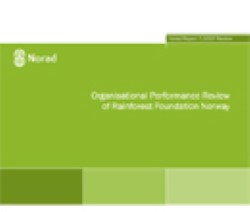Organisational Performance Review of Rainforest Foundation Norway
Om publikasjonen
- Utgitt: oktober 2007
- Serie: [Missing text '/property/enum/publicationserie/7' for 'Norwegian']
- Type: Norad-rapport
- Utført av: Olav Bakken Jensen and Erik Whist (Scanteam)
- Bestilt av: Norad
- Land:
- Tema: Klima og miljø
- Antall sider: 73
- Serienummer: 9/2007
- ISBN: 978-82-7548-240-0
- ISSN: --

Conclusions
RFN's ability to provide effective aid:
This Review finds that with few exceptions
RFN is meeting the objectives and delivering the expected results drawn up in the Framework Agreement with Norad.
The cost-efficient use of funds:
RFN is rather cost efficient in its operations and use of funds at head quarters as well as field level.
The relevance to Norwegian political priorities on environment and indigenous peoples:
This is well documented. RFN has actively influenced Norwegian policies in both these areas. With its new strategy RFN is also pursuing gender equality in its work.
Results in accordance with agreed goals in the multi year agreement:
RFN is achieving almost all indicators for the various results in the Framework Agreement with Norad.
Relevance to the partners and the local and national political situation:
RFN's relevance to its partners is almost self evident. The relevance to the national political situation will vary.
RFN's professional, financial and administrative capacity:
It seems clear that until now RFN has the professional and administrative capacity to implement Norad financed measures and programmes under the Framework Agreement. However, there is a feeling in RFN that this capacity is now overstretched. With the two new programmes (Norad Indigenous Peoples' Programme and the MFA Amazon Programme) as well as RFN's new expansive strategy there is a danger that the capacity will not be adequate in the future. So far RFN has been able to meet all requirements for its financial capacity. Its fundraising has almost doubled from NOK 2 868 086 in 2003 to 5 350 000 (budget figure) in 2007. RFN has also accumulated and set a side a special fund to meet Norad's requirement for own financing (10 % of project cost) in case RFN should not be able to meet this.
RFN's system for management and control of its own activities:
RFN has an adequate computerised financial management system, but no proper computerised project management information system. The present system relies very heavily on reporting inputs from the partners. The RFN staff expresses that there is much room for improving the systematic inputs on reporting from the partners, which is mostly of a narrative nature with more focus on activities than on results with corresponding indicators.
Recommendations
Structure, organisation and management:
It is the view of the Review Team that it will be difficult to maintain the same flat structure of the RFN's organisation in the future. It is recommended that RFN undertakes an organisational assessment of what the envisaged expansion will imply in terms of:
• RFN internal structure
• Organisation of responsibilities, tasks and communication
• Work methods and administrative procedures
It is recommended that RFN considers the need to strengthen its resources working on administration. It is recommended that the Board and the RFN administration look into whether and if so how the Board may adopt more of the control functions boards usually exercise.
RFN has a well qualified staff. It is not suggested to change the professional profile of this, but it is recommended that RFN should make more efforts to encourage its staff to profit from RFN's policy to support staff in upgrading and updating their skills.
Revenues:
RFN should vigorously pursue different possibilities for funding, particularly private sources, but also funding from other Nordic countries and
international organisations and foundations.
Planning, monitoring and reporting in cooperation with partners:
• It is recommended that in the Framework Agreement with Norad the part goals of the new strategy are used or reformulated as expected results and
that an effort is made to limit the number of indicators for each of these.
• It is recommended that when formulating indicators for the part goals or expected results both performance indicators as well as outcome and impact
indicators are included and to the extent possible quantified.
• It is recommended that a systematic effort is undertaken to identify how every indicator is to be monitored (means of verification)
• It is recommended that RFN establishes baseline information for each part goal in each of the programmes.
• It is recommended that RFN spends more time with each contract partner on building up a coherent system for monitoring, which takes into account how the achievement of selected RFN part goals is being achieved through the different activities undertaken by the partner at different level.
• It is recommended that RFN makes an effort to finish its project manual
Selection of partners: It is recommended that RFN maintains an open ended and inclusive approach in their selection of local partners to avoid detrimental discussions on partners' legitimacy.
RFN local community activities:
It is recommended that RFN continues and strengthens its resource mapping and resource based planning at community level.
RFN should also explore how it may support non timber based forest alternative income activities, particularly in communities where participatory mapping and planning have taken place.
Some special recommendations
• The new strategy now has a statement on gender. It is recommended that RFN makes this explicitly clear to all its contract partners.
• When RFN supports activities which require technical skills (e.g. participatory mapping). RFN should strengthen its quality control of inputs (both people and equipment), the training provided and the results achieved.
• RFN should consider how it may more actively use the ILO convention 169 as a means for promoting the rights of indigenous peoples in different countries.
Se nyhetssak om gjennomgangen
